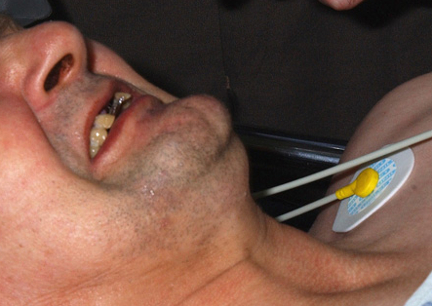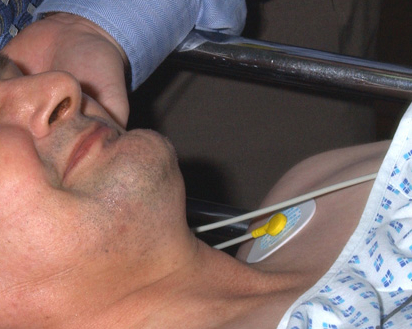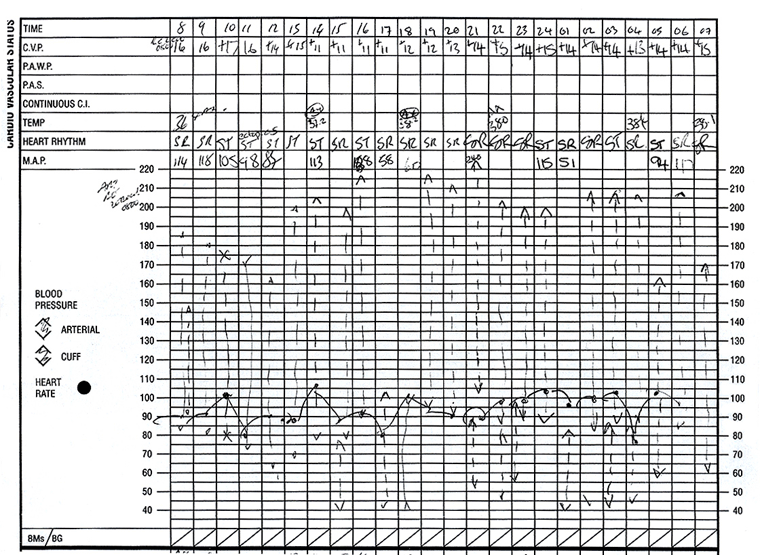Case history
Case history
A 63-year-old man sustained a cut on his hand while gardening. His immunisation history is significant for not having received a complete tetanus immunisation schedule. He presents with signs of generalised tetanus with trismus ('lock jaw'), which results in a grimace described as 'risus sardonicus' (sardonic smile). Intermittent tonic contraction of his skeletal muscles causes intensely painful spasms, which last for minutes, during which he retains consciousness. The spasms are triggered by external (noise, light, drafts, physical contact) or internal stimuli, and as a result he is at the risk of sustaining fractures or developing rhabdomyolysis. The tetanic spasms also produce opisthotonus, board-like abdominal wall rigidity, dysphagia, and apnoeic periods due to contraction of the thoracic muscles and/or glottal or pharyngeal muscles. During a generalised spasm the patient arches his back, extends his legs, flexes his arms in abduction, and clenches his fists. Apnoea results during some of the spasms. Autonomic over-activity initially manifests as irritability, restlessness, sweating, and tachycardia. Several days later this may present as hyper-pyrexia, cardiac arrhythmias, labile hypertension, or hypotension.[Figure caption and citation for the preceding image starts]: TrismusFrom the collections of Nicholas J. Beeching and Christopher M. Parry [Citation ends]. [Figure caption and citation for the preceding image starts]: TrismusFrom the collections of Nicholas J. Beeching and Christopher M. Parry [Citation ends].
[Figure caption and citation for the preceding image starts]: TrismusFrom the collections of Nicholas J. Beeching and Christopher M. Parry [Citation ends]. [Figure caption and citation for the preceding image starts]: OpisthotonusFrom the collections of Nicholas J. Beeching and Christopher M. Parry [Citation ends].
[Figure caption and citation for the preceding image starts]: OpisthotonusFrom the collections of Nicholas J. Beeching and Christopher M. Parry [Citation ends]. [Figure caption and citation for the preceding image starts]: Observation chart illustrating autonomic dysfunction with extreme fluctuation in blood pressureFrom the collections of Nicholas J. Beeching and Christopher M. Parry [Citation ends].
[Figure caption and citation for the preceding image starts]: Observation chart illustrating autonomic dysfunction with extreme fluctuation in blood pressureFrom the collections of Nicholas J. Beeching and Christopher M. Parry [Citation ends].
Other presentations
Localised tetanus presents with muscle spasms limited to one extremity or body region near the site of injury. It may become generalised if the diagnosis is not recognised. Alternatively it may persist for weeks or months with subsequent complete resolution.[1] Cephalic tetanus follows head injury or middle ear infection with a short incubation period of 1 to 2 days. Cranial nerve palsies occur that may progress to generalised tetanus. The facial nerve is most frequently affected.[1] Patients may present with dysphagia, trismus, and/or focal cranial neuropathies. Neonatal tetanus usually presents 3 to 14 days postnatal, mostly on days 6 to 8.[2] Trismus and lip muscle rigidity interfere with normal sucking and feeding and the child is irritable. Early features include excessive crying and poor feeding. As the disease progresses, muscle rigidity extends throughout the body and spasms commence. Opisthotonus, seizures, and autonomic disturbance occur. The onset period, or time from first symptom to first spasm, ranges from a few hours to 5 days, usually 1 to 3 days.[2] Onset and progression are more rapid than in non-neonatal tetanus, possibly as a result of shorter axonal length.
Use of this content is subject to our disclaimer